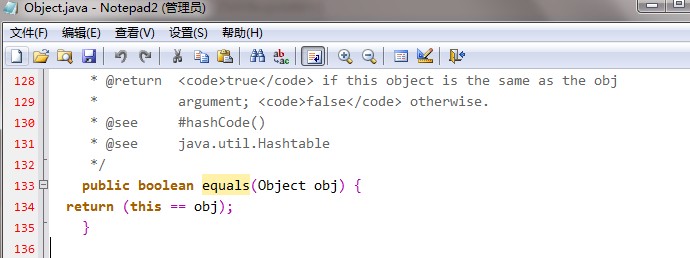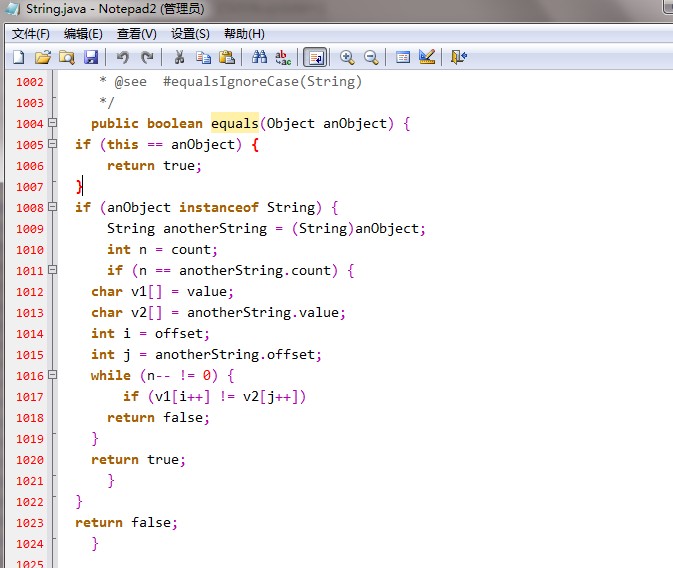A brief discussion of equals and == in Java
When you first learn Java, you may often encounter the following code:
String str1 = new String("hello");
String str2 = new String("hello");
System.out.println(str1==str2);
System.out.println(str1.equals(str2));Why are the output results of lines 4 and 5 different? What is the difference between == and equals methods? If you don't figure this out when you first learn Java, you will make some low-level errors when writing code in the future. Today let’s learn about the difference between == and equals methods.
1. What exactly does the relational operator "==" compare?
The following sentence is an original quote from the book "Java Programming Thoughts":
"Relational operators generate a boolean result, and they calculate the relationship between the values of the operands."
This sentence seems simple, but it still needs to be understood carefully. To put it simply, == is used to compare whether values are equal. Let’s take a look at a few examples:
public class Main {
/**
* @param args
*/
public static void main(String[] args) {
// TODO Auto-generated method stub
int n=3;
int m=3;
System.out.println(n==m);
String str = new String("hello");
String str1 = new String("hello");
String str2 = new String("hello");
System.out.println(str1==str2);
str1 = str;
str2 = str;
System.out.println(str1==str2);
}
}The output result is true false true
The result of n==m is true. This is easy to understand. The values stored in variable n and variable m are both 3, which must be equal. And why are the results of the two comparisons of str1 and str2 different? To understand this, you only need to understand the difference between basic data type variables and non-basic data type variables.
There are 8 basic data types in Java:
Floating point type: float (4 byte), double (8 byte)
Integer type: byte (1 byte), short (2 byte), int (4 byte) , long(8 byte)
Character type: char(2 byte)
Boolean type: boolean (The JVM specification does not clearly stipulate the size of the space it occupies, but only stipulates that it can only take the literal values "true" and "false" )
For the variables of these 8 basic data types, the variables directly store the "value", so when the relational operator == is used for comparison, the "value" itself is compared. It should be noted that floating point and integer types are both signed types, while char is an unsigned type (the value range of the char type is 0~2^16-1).
That is to say, for example:
int n= 3;
int m=3;
Both variable n and variable m directly store the value "3", so when compared with ==, the result is true.
For variables of non-basic data types, they are called reference type variables in some books. For example, str1 above is a reference type variable. A reference type variable stores not the "value" itself, but the address of its associated object in memory. For example, the following line of code:
String str1;
This sentence declares a reference type variable, which is not associated with any object at this time.
And use new String("hello") to generate an object (also called an instance of class String), and bind this object to str1:
str1= new String("hello");
Then str1 points to an object (str1 is also called a reference to an object in many places). At this time, the variable str1 stores the storage address of the object it points to in memory, not the "value" itself, that is to say, it is not The string "hello" is stored directly. The references here are very similar to pointers in C/C++.
So when you use == to compare str1 and str2 for the first time, the result is false. Therefore, they point to different objects respectively, which means that the memory addresses where they are actually stored are different.
In the second comparison, both str1 and str2 point to the object pointed to by str, so the result obtained is undoubtedly true.
2. What does equals compare to?
The equals method is a method in the base class Object, so all classes that inherit from Object will have this method. In order to understand the role of the equals method more intuitively, let's look directly at the implementation of the equals method in the Object class.
The source code path of this class is: Object.java under the java.lang path of src.zip in C:Program FilesJavajdk1.6.0_14 (depending on the personal jdk installation path).
The following is the implementation of the equals method in the Object class:

Obviously, in the Object class, the equals method is used to compare whether the references of two objects are equal, that is, whether they point to the same object.
But some friends may have questions again, why is the output result of the following piece of code true?
public class Main {
/**
* @param args
*/
public static void main(String[] args) {
// TODO Auto-generated method stub
String str1 = new String("hello");
String str2 = new String("hello");
System.out.println(str1.equals(str2));
}
}To know what is going on, you can look at the specific implementation of the equals method of the String class. Also under this path, String.java is the implementation of the String class.
The following is the specific implementation of the equals method in the String class:

It can be seen that the String class has rewritten the equals method to compare whether the strings stored in the pointed string objects are equal.
Some other classes, such as Double, Date, Integer, etc., have overridden the equals method to compare whether the contents stored in the pointed objects are equal.
In summary:
1) For ==, if it acts on a variable of a basic data type, it will directly compare whether its stored "value" is equal;
If it acts on a variable of a reference type, it will compare the address of the pointed object
2) For the equals method, note: the equals method cannot act on variables of basic data types
If the equals method is not overridden, the address of the object pointed to by the reference type variable is compared;
such as String, Date If a class overrides the equals method, the contents of the pointed objects are compared.
For more articles related to equals and == in Java, please pay attention to the PHP Chinese website!

Hot AI Tools

Undresser.AI Undress
AI-powered app for creating realistic nude photos

AI Clothes Remover
Online AI tool for removing clothes from photos.

Undress AI Tool
Undress images for free

Clothoff.io
AI clothes remover

Video Face Swap
Swap faces in any video effortlessly with our completely free AI face swap tool!

Hot Article

Hot Tools

Notepad++7.3.1
Easy-to-use and free code editor

SublimeText3 Chinese version
Chinese version, very easy to use

Zend Studio 13.0.1
Powerful PHP integrated development environment

Dreamweaver CS6
Visual web development tools

SublimeText3 Mac version
God-level code editing software (SublimeText3)

Hot Topics
 1392
1392
 52
52
 How to elegantly obtain entity class variable names to build database query conditions?
Apr 19, 2025 pm 11:42 PM
How to elegantly obtain entity class variable names to build database query conditions?
Apr 19, 2025 pm 11:42 PM
When using MyBatis-Plus or other ORM frameworks for database operations, it is often necessary to construct query conditions based on the attribute name of the entity class. If you manually every time...
 Is the company's security software causing the application to fail to run? How to troubleshoot and solve it?
Apr 19, 2025 pm 04:51 PM
Is the company's security software causing the application to fail to run? How to troubleshoot and solve it?
Apr 19, 2025 pm 04:51 PM
Troubleshooting and solutions to the company's security software that causes some applications to not function properly. Many companies will deploy security software in order to ensure internal network security. ...
 How to simplify field mapping issues in system docking using MapStruct?
Apr 19, 2025 pm 06:21 PM
How to simplify field mapping issues in system docking using MapStruct?
Apr 19, 2025 pm 06:21 PM
Field mapping processing in system docking often encounters a difficult problem when performing system docking: how to effectively map the interface fields of system A...
 How does IntelliJ IDEA identify the port number of a Spring Boot project without outputting a log?
Apr 19, 2025 pm 11:45 PM
How does IntelliJ IDEA identify the port number of a Spring Boot project without outputting a log?
Apr 19, 2025 pm 11:45 PM
Start Spring using IntelliJIDEAUltimate version...
 How to safely convert Java objects to arrays?
Apr 19, 2025 pm 11:33 PM
How to safely convert Java objects to arrays?
Apr 19, 2025 pm 11:33 PM
Conversion of Java Objects and Arrays: In-depth discussion of the risks and correct methods of cast type conversion Many Java beginners will encounter the conversion of an object into an array...
 What is the difference between memory leaks in Java programs on ARM and x86 architecture CPUs?
Apr 19, 2025 pm 11:18 PM
What is the difference between memory leaks in Java programs on ARM and x86 architecture CPUs?
Apr 19, 2025 pm 11:18 PM
Analysis of memory leak phenomenon of Java programs on different architecture CPUs. This article will discuss a case where a Java program exhibits different memory behaviors on ARM and x86 architecture CPUs...
 How to use the Redis cache solution to efficiently realize the requirements of product ranking list?
Apr 19, 2025 pm 11:36 PM
How to use the Redis cache solution to efficiently realize the requirements of product ranking list?
Apr 19, 2025 pm 11:36 PM
How does the Redis caching solution realize the requirements of product ranking list? During the development process, we often need to deal with the requirements of rankings, such as displaying a...
 How to convert names to numbers to implement sorting within groups?
Apr 19, 2025 pm 01:57 PM
How to convert names to numbers to implement sorting within groups?
Apr 19, 2025 pm 01:57 PM
How to convert names to numbers to implement sorting within groups? When sorting users in groups, it is often necessary to convert the user's name into numbers so that it can be different...




